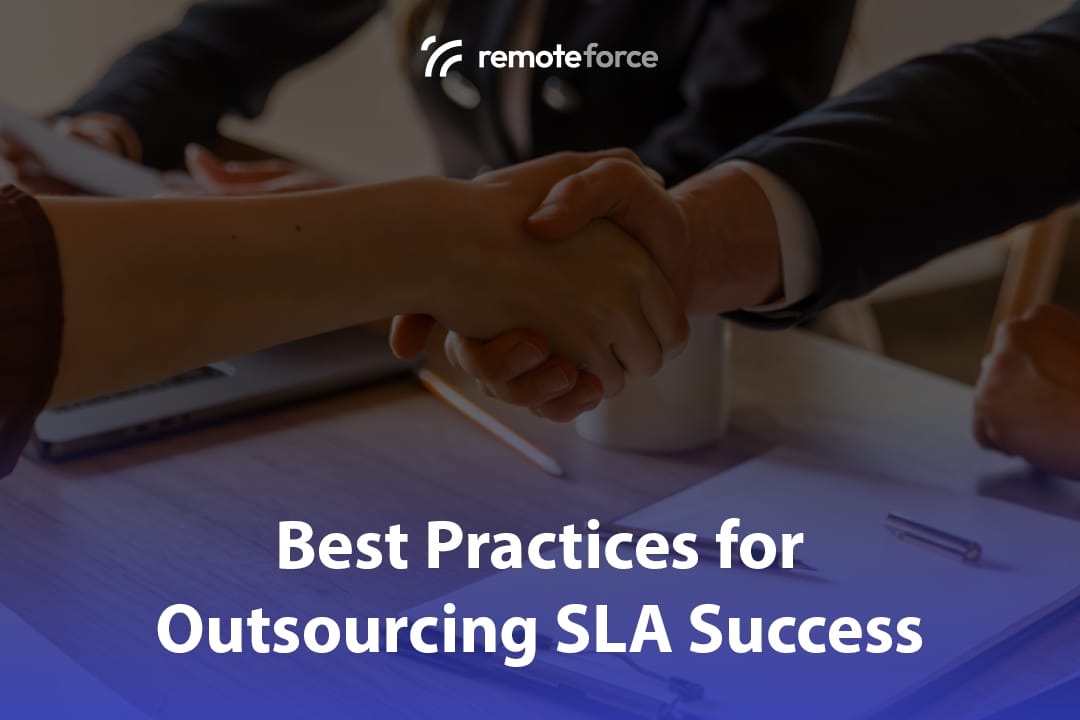A Service Level Agreement (SLA) is more than just a document; it is the fundamental contract that governs the relationship between a client and an outsourcing vendor. It explicitly defines the service standards, responsibilities, reporting mechanisms, and penalties for non-performance.
For companies outsourcing high-value functions—from specialized legal and accounting support to dynamic digital marketing and web development—a robust SLA is essential for risk mitigation and ensuring measurable success.
Table of Contents
ToggleOutsourcing Service Level Agreements
Here are the best practices for designing, negotiating, and managing effective Outsourcing Service Level Agreements.
1. Define Services and Metrics with Precision
Vague language is the number one enemy of a good SLA. The best practice is to define every deliverable and its corresponding success metric clearly and quantitatively.
🎯 Key Practice: Adopt SMART Metrics
Your metrics must be Specific, Measurable, Achievable, Relevant, and Time-bound (SMART).
| Component | Vague Definition (Avoid) | SMART Definition (Best Practice) |
|---|---|---|
| Service Scope | “The vendor will manage social media.” | “The vendor will manage all content creation and posting across LinkedIn and Instagram, 5 days per week.” |
| Performance | “Website speed must be fast.” | “Page Load Time (PLT) must be maintained at an average of under 3.0 seconds during peak hours (9 AM – 5 PM local time).” |
| Availability | “Support should be available.” | “Technical support (Tier 2) must be available 99.9% of the time, 24/7/365, excluding pre-scheduled maintenance.” |
| Response Time | “Handle customer queries quickly.” | “Initial response to critical security incidents must occur within 15 minutes of notification.” |
🔑 Actionable Tip: Baseline Before Negotiation
Always conduct a baseline assessment of your current internal performance before negotiating new standards. This ensures the targets set in the SLA are realistic and achievable, avoiding immediate failure or unrealistic demands.
2. Establish Clear Governance and Reporting Protocols
Even the best SLA is useless without a defined process for monitoring and reviewing performance. Governance dictates how the agreement is managed.
📊 Key Practice: Mandate Transparent Reporting
The SLA must specify the exact reporting structure:
- Data Sources: Where does the performance data come from (e.g., Google Analytics, specific ATS, ticketing system)?
- Reporting Frequency: Daily dashboards for critical metrics, weekly performance reports, and monthly executive summaries.
- Format: The format should be standardized (e.g., dashboard access, PDF report) and easy for the client to interpret.
🤝 Key Practice: Define Review Cadence
Set up a clear schedule for formal reviews:
- Operational Reviews: Weekly or bi-weekly meetings between the client’s project manager and the vendor’s team lead to address immediate issues.
- Strategic Reviews: Quarterly meetings at the executive level to assess long-term goals, adjust strategy, and confirm contract satisfaction.
3. Implement Effective Penalty and Reward Mechanisms
An SLA must have teeth. Without consequences for poor performance and incentives for exceptional performance, the vendor lacks motivation.
📉 Key Practice: Structure Service Credits (Penalties)
Service credits are the standard penalty for non-compliance. They involve a deduction from the monthly service fee when performance falls below the agreed-upon threshold.
- Tiers: Create tiered penalties. A slight miss might incur a 2% credit, while a catastrophic failure (e.g., a major data breach) could result in an immediate 10% credit or grounds for termination.
- Focus on the Critical: Penalties should focus on the metrics most crucial to the client’s business (e.g., failure to meet target Quality of Hire for specialized roles).
📈 Key Practice: Include Performance Incentives
The best partnerships reward success. Incentives encourage the vendor to view the client’s success as their own.
- Bonus Structure: Offer a bonus percentage (e.g., 2-5%) of the monthly fee if they exceed a high-tier performance goal (e.g., consistently maintaining 99.99% system uptime or exceeding lead generation targets).
- Renewals and Expansion: Use incentives tied to contract renewal terms or preferential access to new project expansions.
4. Prioritize Security, Confidentiality, and Compliance
In specialized outsourcing (like legal or accounting), compliance breaches are often more damaging than performance issues.
🛡️ Key Practice: Separate Security SLAs
Create a distinct section focused solely on Information Security and Compliance. This should cover:
- Data Security Breaches: Define the immediate reporting timeline (e.g., “within 2 hours”) and the vendor’s required action plan.
- Regulatory Compliance: Require the vendor to adhere to relevant industry regulations (e.g., HIPAA for healthcare, GDPR for EU data).
- Audit Rights: The client must reserve the right to perform independent, third-party security audits of the vendor’s facilities and systems with reasonable notice.
5. Include Review, Change, and Termination Procedures
SLAs are living documents that must adapt to changing business needs.
🔄 Key Practice: Define the Change Process
Specify how and when the SLA can be updated.
- Periodic Review: Schedule mandatory annual or bi-annual SLA review meetings.
- Change Management: Outline the formal process for requesting changes to metrics or services, including approval timelines and required documentation.
🛑 Key Practice: Detail Termination Rights
The SLA should clarify termination rights, especially those related to non-performance.
- Cure Period: Allow the vendor a short, defined period (e.g., 30 days) to “cure” a performance breach before the client can invoke termination rights.
- Immediate Termination: Specify rare, catastrophic events (e.g., a massive data breach, insolvency, or repeated legal non-compliance) that allow the client to terminate the contract immediately without penalty.
Conclusion
A well-crafted Service Level Agreement is the essential blueprint for a thriving, low-risk outsourcing partnership. By focusing on SMART metrics, transparent governance, balanced penalties, and robust security protocols, your business ensures it receives the premium service it pays for.
At RemoteForce, our commitment to providing expert, legally compliant manpower—whether for secretarial, development, or accounting needs—is backed by clear, enforceable SLAs. We integrate industry best practices into every partnership, giving you the confidence that your outsourced team is committed not just to their work, but to your measurable success. Are you ready to build an SLA that truly protects and optimizes your business?




